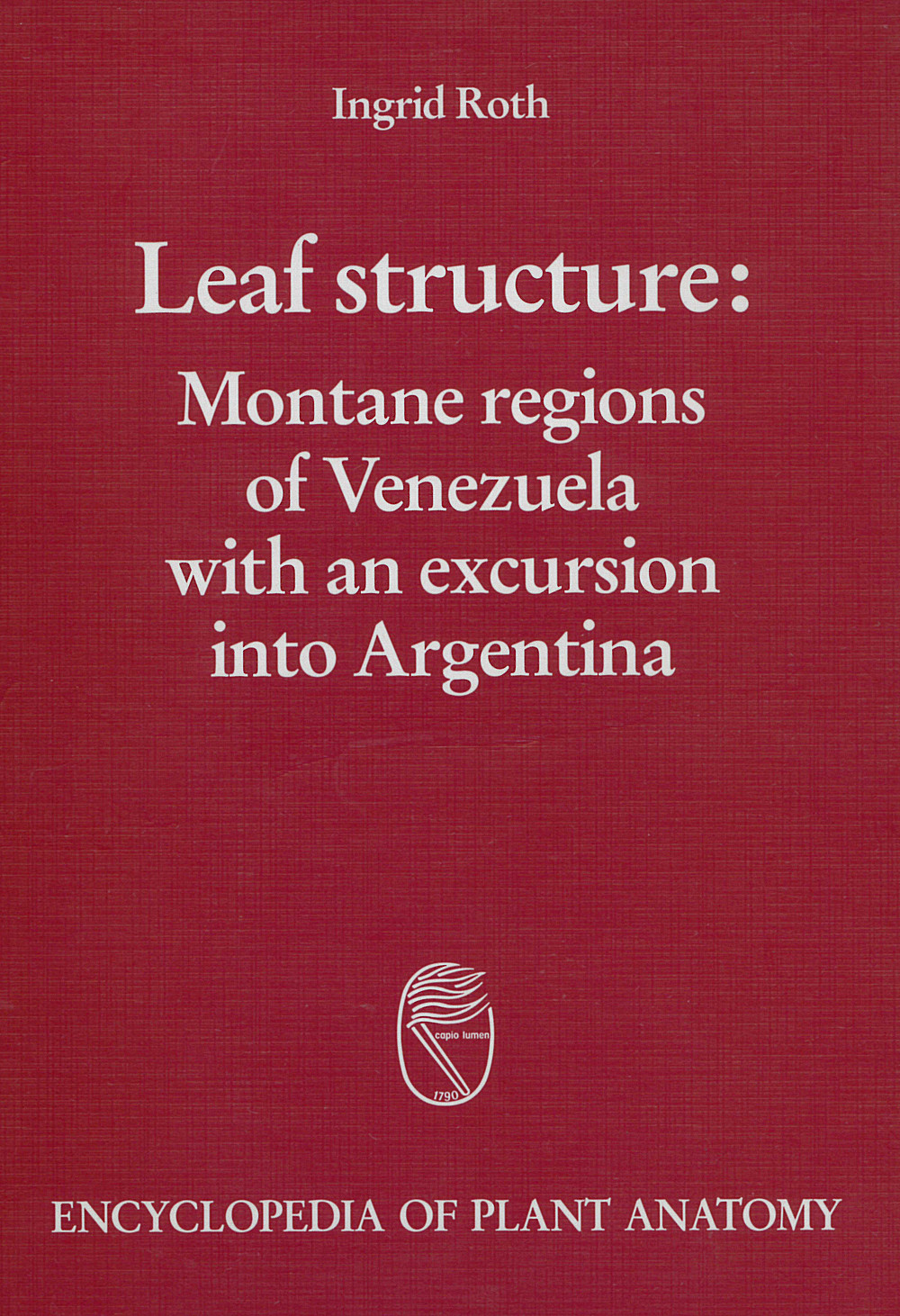Content Description
top ↑
The present monograph treats the leaf structure of plants in a variety of montane habitats. It establishes and discusses relationships between leaf structure and environmental stresses, such as strong isolation, frost and drought. It is mainly based on original observations and studies of plants
in distinct mountainous regions of Venezuela and Argentina by the author, her students and colleagues.
The studied plants apply a wide range of stategies to adapt themselves to the environmental conditions of their habitat: they use very different structural characteristics, such as reduction of the surface/volume ratio, rolled leaves, crypts, water-storing tissues, thick and cutinized upper epidermis cells or tannic substances with a protective function against UV radiation. A colourless parenchyma may be the consequence of chlorophyll decomposition by excessive isolation. Leathery leaf consistency found in many species studied is due to a variety of anatomical structures. In Senecio rex, the extremely thick walls of the palisade cell cause this texture. Sun leaves were observed in most of the species. Leaf consistency and leaf fall are related to one another.
The most xeromorphic adaptions are found in Espeletia at elevations between 2000 and 4000 m a.s.l. Besides anatomaical observations also physiological and ecophysiological aspects are discussed. Many andine species are useful. Krameria lappacea was almost extinct because of its tannin content. Medical uses of the paramo plants Espeletia and Carramboa are described.
Andean regions 1
The Paramos 1
Flora 3
Structure of the Espeletia leaves 9
Leaf anatomy of Espeletia timotensis 10
Indumentum 11
Types of hairs 12
The crypts 14
Secretory canals 23
Leaf development 27
Espeletia atropurpurea A.C.Sm 30
Comparison of both species 31
Conclusions 32
Espeletia neriifolia (H.B.K.) Sch. Bip 34
The genus Carramboa 35
Carramboa little) (Aristeg.) Cuatr 35
Carramboa pittieri (Cuatr.) Cuatr 36
Carramboa rodriguezii (Cuatr.) Cuatr 36
Carramboa badilloi (Cuatr.) Cuatr 38
Carramboa trujillensis (Cuatr.) Cuatr 39
Medicinal use of Espeletia and Carramboa 41
Hinterhubera imbricata Cuatr. & Aristeguieta 42
The apical part of the leaf 42
The middle part of the leaf 44
The basal part of the leaf 49
Leaf development 53
Conclusions 53
Chaetolepis lindeniana Trian 55
Morphological description 56
The indumentum 56
The hairs of the axis 57
The hairs of the upper leaf side 57
The hairs of the lower leaf side 57
Inner structure of the adult leaf 58
Upper epidermis 59
Mesophyll 62
Lower epidermis 62
Ribs 62
Development of the leaf 65
Discussion and conclusions 69
Polylepis 75
Paramo species used as medicinal plants 81
Gnaphalium antennarioides D C. 81
Senecio rex 83
Gaultheria procumbens 88
Gentiana nevadensis Gilg 91
Satureia browned 92
Angelonia salicariaefolia H & B 92
Sisyrinchium micranthum Cav 93
Hierochloe mexicana Benth 95
Physioecological aspects and paramo plants 98
Arracacia esculenta DC 112
Krameria lappacea (Dombey) Burdet & Simpson, an Andean half-shrub
(Halbstrauch) 120
Leaf blade 123
Leaf petiole 128
Axis 128
Discussion 130
Cecropia palmatisecta Cuatr. 132
Leaf structure of various tree species from the lowest level
of an Andean mountain forest of Tucuman 132
Leaf morphology 133
Allophylus edulis (St. Hill) Radlk 133
Cupania vernalis Cambess 133
Sapindus saponaria L 133
Myrcianthes pungens Berg 135
Fagara coco (Gill.) Engler 135
Phoebe porphyria (Griseb.) Mez 136
Piper tucumanum C. DC 136
Rapanea laetevirens Mez 136
Tipuana tipu (Berth.) O. Kuntze 137
Juglans australis Griseb. 138
Inner structure of the leaves 138
Allophylus edulis 138
Cupania vernalis 140
Sapindus saponaria 142
Myrcianthespungens 144
Fagara coco 146
Phoebeporphyria 149
Pipertucumanum 149
Rapanealaetevirens 153
Tipuana tipu 156
Juglansaustralis 159
Comparison of the leaf structure of the 10 species studied 161
Leaf consistency and leaf fall 162
Possible relations between leaf structure and environment 163
Cordillera de la Costa 168
Passiflora 169
Leaf shape 170
Inner leaf structrue of Passiflora cuneata Willd 174
Development and structure of the glands on the limb 176
The extrafloral nectaries of Passiflorafoetida L. 178
Development 179
Structure of the gland and comparison with other tentacles 180
Discussion and conclusions 183
13 species from the Pico Naiguata 184
Leaf anatomy 186
SymplocossuaveolensKlotzsch 186
Myrica caracasana H.B.K 188
Berberis vitellina Hieron 191
RoupalapseudocordataPittier 193
Arcytophyllum caracasanum (H.B.K.) Schlecht subsp. caracasanum
(H.B.K.) Steyerm. 195
Siphocampylus reticulatus (Willd.) Vatke, Kl. & Karst 198
Vaccinium meridionale S W. 198
Weinmannia hansbergiana Engler 200
Gaiadendron tagua (H.B.K.) D. Don 201
Hesperomeles glabrata H.B.K 202
Befaria ledifolia H.B.K 204
Eupatorium steetzli Rob 206
Espeletia neriifolia (H.B.K.) Sch. Bip. ex Wedd 207
Discussion 209
The mesetas of the Guianan highlands 213
Tepuianthus auyantepuiensis Maguire & Steyermark 214
Leaf structure 215
Bark structure 221
Ecological interpretation of the leaf structure 226
Similar structures in leaves of other species 229
Final observations 230
Bibliography 237
General Index 244
